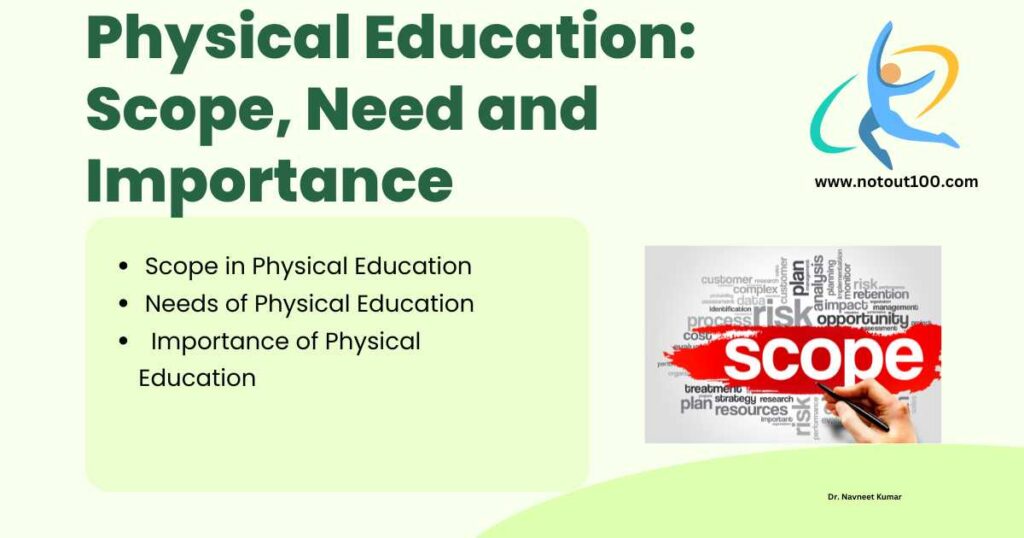
Scope Of Physical Education
The domain of physical education is extensive, allowing every individual to work according to their preferences. The scope of physical education can be categorized as follows:
1. Exercise: Through exercise, children’s physical deficiencies can be mitigated. All such deficiencies are addressed correctly through engagement in exercise.
2. Sports and Games: There are two types of activities in sports and games. Some games are played indoors, referred to as indoor games, while others are played outdoors, referred to as outdoor games. These games can be individual or team-based, encompassing various types of sporting activities.
3. Physiotherapy Activities: Physiotherapy can alleviate certain disabilities and injuries, ensuring physical well-being and recovery.
4. Management and Organization: In physical education, children learn management skills through sports, enabling them to manage all tasks effectively in their lives. They also organize sports competitions and learn various types of management techniques. The Importance and Necessity of Physical Education: In this modern era, there is an increased emphasis on academic achievement for children, with less attention given by parents to their physical activities.
However, the effective functioning of any task requires the combined effort of both the body and the mind. If the mind instructs the body to work, but the body does not respond appropriately, the mind will also cease to function effectively. Therefore, it is crucial to understand that no task can be performed without the involvement of the body. By acquiring knowledge of physical education, children learn the art of staying healthy.
In this advancing age, there are various diseases that affect children from a young age. All these diseases can be prevented through exercise, such as eye diseases, skin diseases, monthly disorders in girls, infections, measles, respiratory diseases, digestive diseases, and others.
Physical education plays an indispensable role in a person’s life. Its effects are not easily described and can only be truly understood by experiencing them firsthand. Physical education demonstrates the path to making life organized, contributing significantly to our existence.
1. Physical education fosters personal development.
2. It instills self-confidence.
3. Provides knowledge about hygiene and diseases.
4. Keeps the body physically fit.
5. Provides knowledge about nutrition.
6. Stimulates mental activity through sports.
7. Harmonizes both mind and body.
8. Assists in making informed life choices through acquired knowledge of physical education.
Relationship in Physical Education and Education
Physical education has a profound relationship with education because it helps achieve the educational objectives. The knowledge gained through education is practically applied through physical education. To achieve educational goals, an individual’s health is essential, as an unhealthy person cannot perform any task efficiently. Some key points related to this are:
1. Mental Health: To achieve education, mental health is crucial. Physical education promotes mental well-being. For achieving goals in sports, new techniques are usually adopted. The environment of the playground is always trying something new. Physical education maintains mental health and provides opportunities to understand and act according to circumstances.
2. Knowledge of Health: Through physical education, we gain practical knowledge of body structure. We learn the correct ways to sit, walk, and stand through physical education. Enhancing all these physical elements can prevent physical defects and achieve good strength.
3. Family and Social Strength: Through physical education, an individual stays healthy through exercise and sports. They can impart knowledge on maintaining health to their family and community. Families and communities can be protected from various diseases. Government health-related schemes can be effectively utilized. Education and physical education together contribute to social welfare.
4. Participation: Physical education demonstrates working together. All are represented as a team or organization during sports. Sports unite everyone, as competitors join hands and enjoy the game together. The goal of education is also to bring everyone together.
5. Achieving Goals: A team in sports has its goal. To achieve this, everyone plays collectively and cheers on the field. Physical education teaches children how to set goals and achieve them.